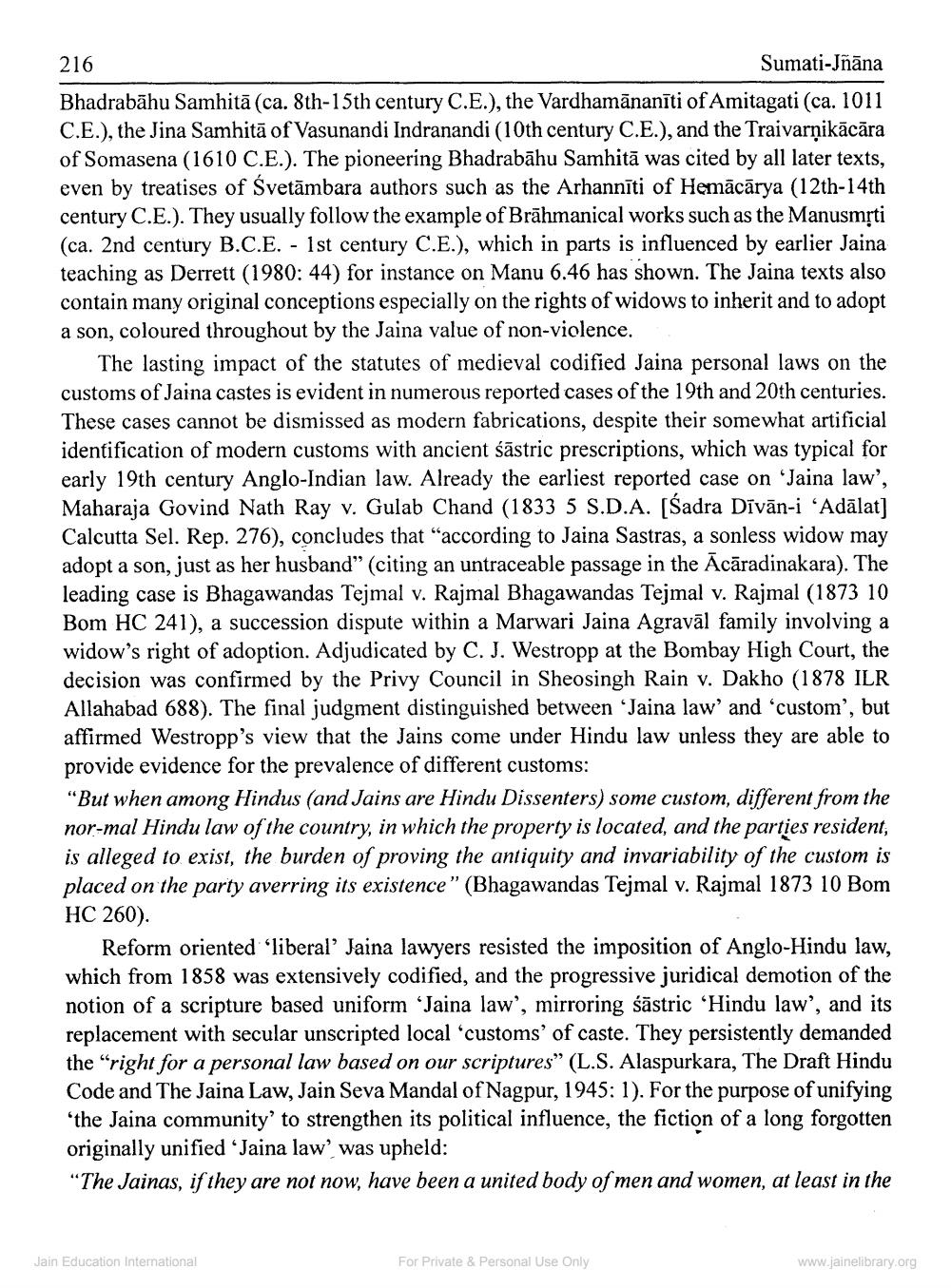________________
216
Sumati-Jnāna
Bhadrabāhu Samhitā (ca. 8th-15th century C.E.), the Vardhamānanīti of Amitagati (ca. 1011 C.E.), the Jina Samhitā of Vasunandi Indranandi (10th century C.E.), and the Traivarņikācāra of Somasena (1610 C.E.). The pioneering Bhadrabāhu Samhitā was cited by all later texts, even by treatises of Svetāmbara authors such as the Arhannīti of Hemācārya (12th-14th century C.E.). They usually follow the example of Brāhmanical works such as the Manusmrti (ca. 2nd century B.C.E. - 1st century C.E.), which in parts is influenced by earlier Jaina teaching as Derrett (1980: 44) for instance on Manu 6.46 has shown. The Jaina texts also contain many original conceptions especially on the rights of widows to inherit and to adopt a son, coloured throughout by the Jaina value of non-violence.
The lasting impact of the statutes of medieval codified Jaina personal laws on the customs of Jaina castes is evident in numerous reported cases of the 19th and 20th centuries. These cases cannot be dismissed as modern fabrications, despite their somewhat artificial identification of modern customs with ancient śāstric prescriptions, which was typical for early 19th century Anglo-Indian law. Already the earliest reported case on “Jaina law', Maharaja Govind Nath Ray v. Gulab Chand (1833 5 S.D.A. [Sadra Dīvān-i 'Adālat] Calcutta Sel. Rep. 276), concludes that “according to Jaina Sastras, a sonless widow may adopt a son, just as her husband" (citing an untraceable passage in the Acāradinakara). The leading case is Bhagawandas Tejmal v. Rajmal Bhagawandas Tejmal v. Rajmal (1873 10 Bom HC 241), a succession dispute within a Marwari Jaina Agravāl family involving a widow's right of adoption. Adjudicated by C. J. Westropp at the Bombay High Court, the decision was confirmed by the Privy Council in Sheosingh Rain v. Dakho (1878 ILR Allahabad 688). The final judgment distinguished between 'Jaina law' and 'custom', but affirmed Westropp's view that the Jains come under Hindu law unless they are able to provide evidence for the prevalence of different customs: "But when among Hindus (and Jains are Hindu Dissenters) some custom, different from the nor-mal Hindu law of the country, in which the property is located, and the parties resident, is alleged to exist, the burden of proving the antiquity and invariability of the custom is placed on the party averring its existence" (Bhagawandas Tejmal v. Rajmal 1873 10 Bom HC 260).
Reform oriented "liberal' Jaina lawyers resisted the imposition of Anglo-Hindu law, which from 1858 was extensively codified, and the progressive juridical demotion of the notion of a scripture based uniform ‘Jaina law', mirroring śāstric ‘Hindu law', and its replacement with secular unscripted local 'customs of caste. They persistently demanded the “right for a personal law based on our scriptures" (L.S. Alaspurkara, The Draft Hindu Code and The Jaina Law, Jain Seva Mandal of Nagpur, 1945: 1). For the purpose of unifying 'the Jaina community' to strengthen its political influence, the fiction of a long forgotten originally unified “Jaina law' was upheld: "The Jainas, if they are not now, have been a united body of men and women, at least in the
Jain Education International
For Private & Personal Use Only
www.jainelibrary.org




